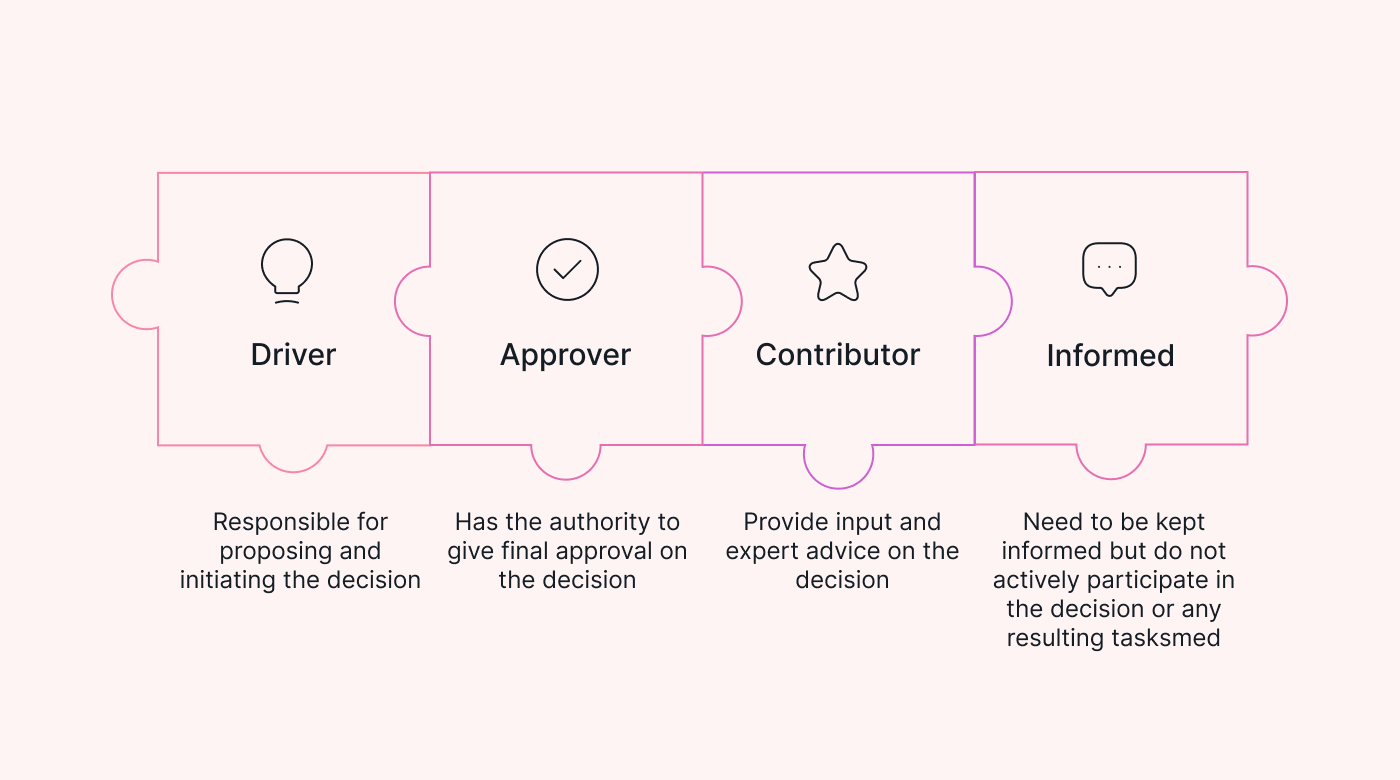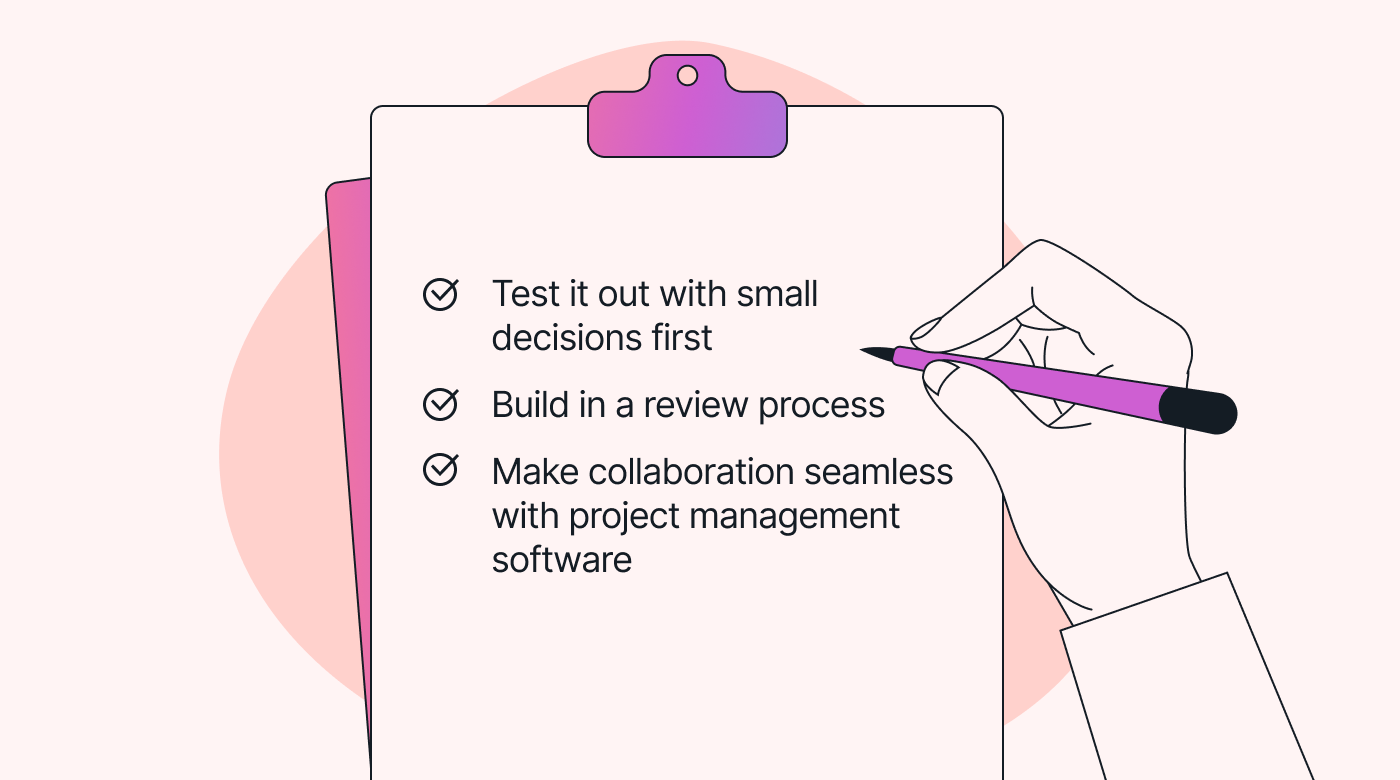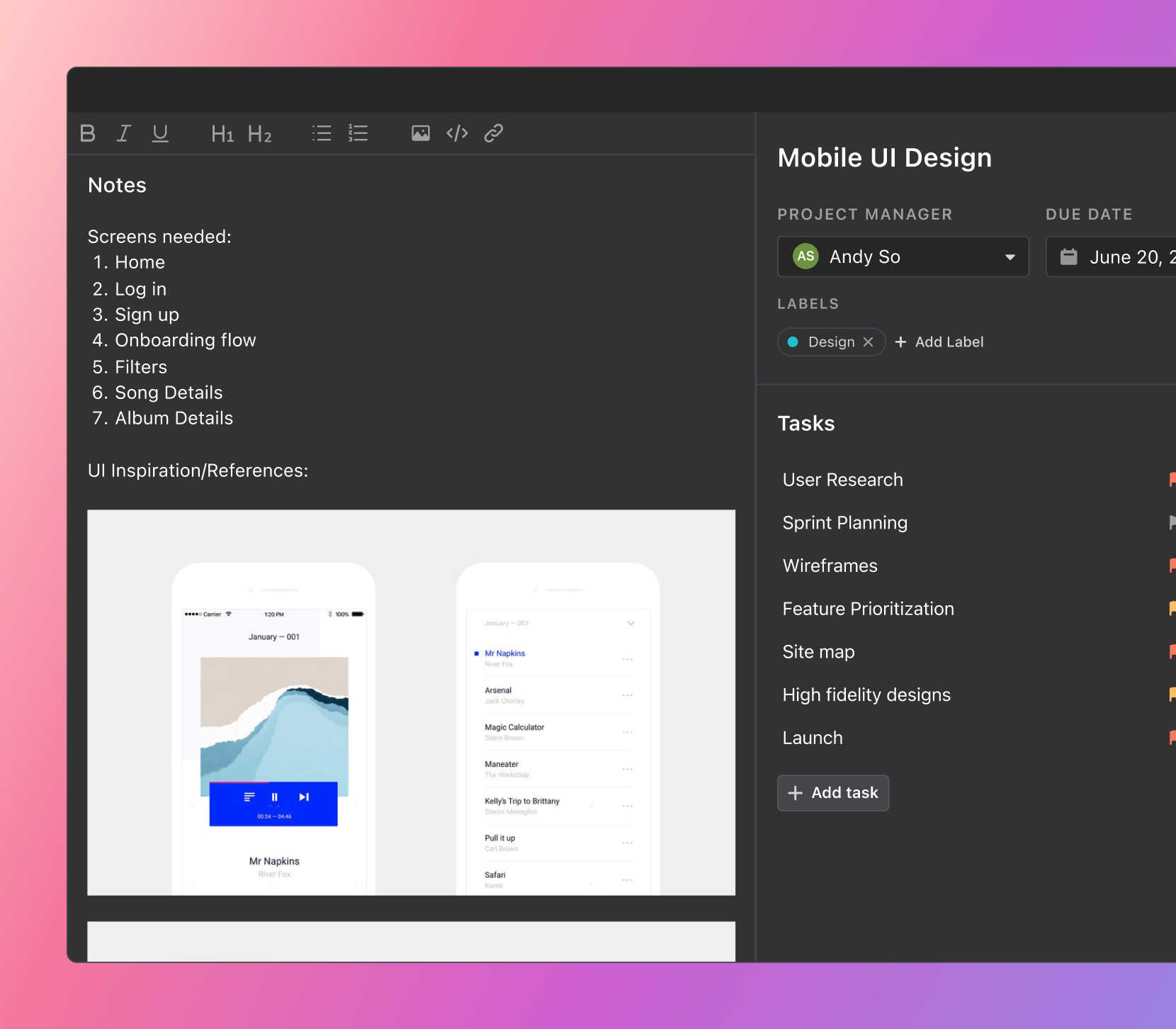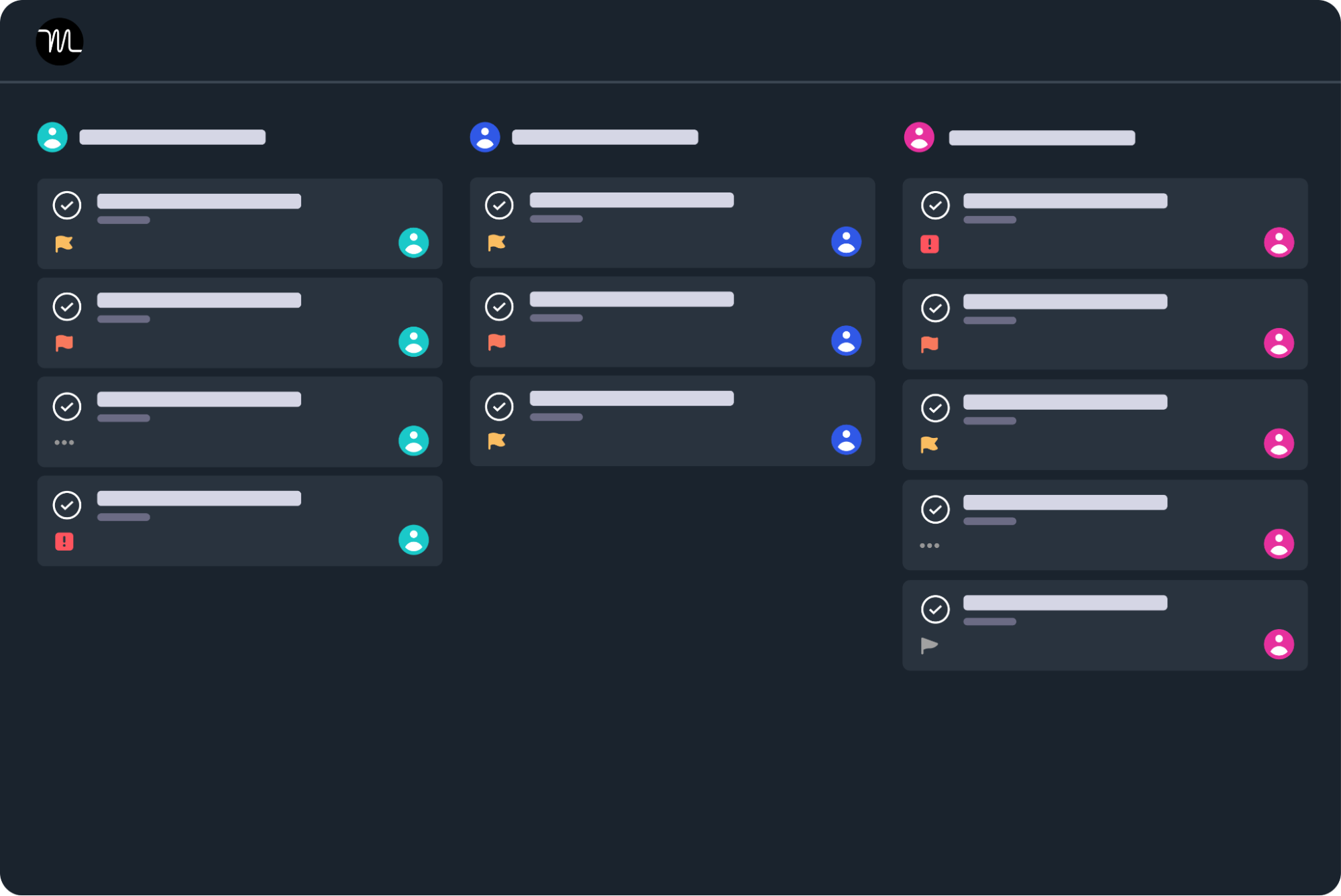Brain fog? Procrastination? You could be suffering from decision fatigue. Did you know that we make around 35,000 decisions a day? It’s no wonder so many business owners feel overwhelmed.
In fact, a recent survey suggests that 70% of business owners would prefer a robot to make their decisions for them. The survey also found that 85% of leaders suffered from “decision distress” and stated they regretted, felt guilty about, or questioned a decision they made in the past year.
This doesn’t even factor in the added stress when you need your team to decide.
What you need is a simple framework to delegate the many choices you have to trusted team members with a process that makes it simple. Enter the DACI decision-making approach.
This article will explore the DACI decision-making framework and help you avoid decision fatigue.
What is the DACI decision-making framework?
When McKinsey surveyed businesses about decision-making, only 20% of respondents said their organizations excelled at decision-making. They also noted that “much of the time they devote to decision-making is used ineffectively.” DACI seeks to remedy this. To streamline decisions, it provides a set of guidelines, roles, and responsibilities for the tasks and decisions within a team environment. But what does DACI stand for?
DACI stands for Driver, Approver, Contributor, and Informed: the four roles of the DACI framework.
DACI and RACI: What’s the difference, and which do I choose?
When it comes to making decisions in your business, there is a line to be drawn between decisions and responsibilities. This distinction is made between DACI and RACI. There are some similarities between the two, but they each serve different purposes.
DACI: Driver, Approver, Contributor, and Informed
DACI’s main focus is decision ownership. It documents who the project driver will be and who can approve or veto choices. There is a process for other stakeholders to contribute information, as well as those who must be kept informed about the progress of decisions.
Reducing confusion and limiting the steps required for making a decision related to a project or task is the ultimate outcome.
RACI: Responsible, Accountable, Consulted, Informed
RACI’s main focus is on clarifying responsibility. It outlines who is responsible for what parts of a project or a task. It defines roles and makes sure everyone knows what they will be held accountable for.
So, how does it work? Well, a person in your project team will be made accountable for the outcome of a task or decision, whether it is successful or fails. They will be made to answer for the results and usually have the authority to make the final decision about the tasks that they have been assigned.
Much like DACI, the decision-making process moves through stages of input from contributors and needs to inform those who should be kept up to date on outcomes.
What are the other decision-making models?
Outside the responsibility matrix and DACI, there are other decision-making frameworks that you can try in your business. It’s important to find the right one for you. There are dozens of frameworks to choose from.
Here are just five to consider:
- ARCI: It has the same roles as the RACI framework, but these steps are performed in a different order.
- MOCHA: It’s more than just delicious coffee. In this iteration, the steps are Manager, Owner, Consultant, Helper, and Approver.
- RAPID: If you’ve got the need for speed, you could instead try Recommend, Agree, Perform, Input, and Decide, but not in that order.
- CAIRO: Not the pyramids but RACI with an ‘O’ to ‘Omit’ the people who don’t need to be involved in the process.
- RASCI: RACI but with an extra support role.
There are hybrids and variations to many of the main frameworks, meaning you can find the version that best suits you and your team’s projects. To learn more about all of the frameworks available to you, you can take a look at this list here.
While there are so many to choose from, for this article, we’ll be exploring DACI in more detail as it forms the foundation for many of the other frameworks and is also the most straightforward to implement.
The four roles of the DACI decision-making framework and what they do
We’ve outlined the four DACI roles, but what do they contribute to better decision-making? How can they simplify complex projects?
Driver
The project driver is the person responsible for kicking off a decision or task. They are the ones who notice that something needs to be done and take the lead in getting it started. This role involves defining what needs to be done, assembling a team, leading the process, and seeking input from others. The driver also presents their recommendations to the rest of the team and ensures the idea gets carried out. In smaller businesses, the owner or founder often handles all these responsibilities, but they can also delegate others to be leaders, especially the approval part.
Approver
The approver is the person who reviews and evaluates the idea presented by the driver. They have the authority to say “yes” or “no” to the idea, and their decision can’t be overridden. The approver considers how the idea might affect everyone involved and assesses any potential risks. After deciding, they communicate their choice to the driver, authorizing the idea’s execution. They also watch implementation to make sure it’s going as planned and that there are no unapproved changes. In small businesses, the owner might take on this role, but it can also be delegated to a project manager or other staff.
 |
Contributor
Contributors actively participate in discussions and meetings about the decision or task. They play a vital role in moving the decision-making process forward by engaging in constructive conversations and helping to clarify any uncertainties. While they offer their insights, contributors understand that the final decision rests with the approver. After a decision is made, they may continue to support its implementation by executing specific tasks or providing ongoing assistance. They can also give feedback on the decision-making process to improve collaboration, efficiency, or future decisions.
Informed
The “informed” individuals or groups aren’t directly involved in deciding or carrying out the task, but they need to know what’s happening. These people can be internal or external stakeholders, including those who will be affected by the decision’s outcome. Informed parties receive updates and information to stay aware of progress and developments. This helps keep things transparent and keeps everyone who needs to know informed about what’s going on. As the boss, you might choose to stay informed but let someone else make the final decision.
Three easy ways to implement DACI decision-making in your business
It’s not an easy process to let go of the reins when you’ve built a business from the ground up, but it is necessary as you grow. Here are three ways you can get started:
 |
1. Test it out with small decisions first:
- Choose some key ideas and test out the process with your most trusted team members.
- Rotate your roles to find the right fit.
- Don’t be afraid to assign multiple roles: Your project manager might approve project decisions, but your CFO might have the last say on internal spending.
- Find your feet first, and once you’re comfortable, you up the ante to more significant decisions.
2. Build in a review process:
- Like any new process in your business, don’t treat this as a one-and-done solution.
- Make sure you’re regularly reviewing the process.
- Check that each role is performing at the highest level.
- Also, make sure that each role has what they need to make decisions effectively, or you may find you’re fielding more questions than ever.
3. Make collaboration seamless with project management software:
- Set expectations with your team by making the approval process simple and central, where the team can communicate their progress.
- Communicate the approval process in your SOPs. You can add these as tasks to your project board so that when tasks are assigned, the steps to follow are already included.

- Set up your staff in a project board with roles clearly assigned.

- Produce regular status updates for the informed directly from your project board.
Let AI-driven project management tools carry the mental load by automating your DACI processes.
Motion and DACI: Your partners in simple decision-making
Say goodbye to decision fatigue and hello to a streamlined approach to decisions in your business. Pair your DACI setup with an AI-driven assistant like Motion that can:
- Auto-schedule tasks to the right staff at the right time
- Create unique daily schedules for your entire project team so all they have to do is log in and get to work.
- Auto-schedule meetings based on your team's availability without the back and forth so decisions can happen quickly.
- You could even set up a dedicated DACI project board where ideas can be presented to the approver regularly without needing meetings.
Don’t let decision fatigue slow you down. Try Motion today!





